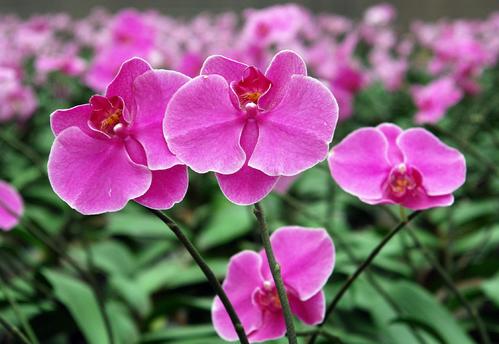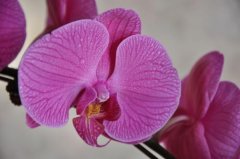Taiwan Phalaenopsis picture, Taiwan Phalaenopsis cultivation technology how to raise Taiwan Phalaenopsis price
Taiwan Phalaenopsis is a Phalaenopsis grown in Taiwan, so it is called Phalaenopsis. The price of this Phalaenopsis is usually 70.00 yuan for half a catty, and 140.00 yuan for seeds per catty. How to breed it?

(1) place: cultivate in a good orchid shed, if the general family training, need to have sunshade and rain protection equipment. Good ventilation can reduce the occurrence of diseases. Place gravel on the ground or store shallow water on it and often keep it moist, which can increase the humidity of the air.
(2) Sunshine: the light needed by Phalaenopsis is darker than that of ordinary orchids, and strong light is not allowed. Orchid sheds can be adjusted with bamboo slices, wood strips or shading nets, shading 70 / 80% in summer, 50 / 60% in spring and autumn, and 40 / 50% in winter.
(3) temperature: the suitable temperature for the growth of Phalaenopsis is 2030 ℃. More than 35 ℃ in summer and less than 10 ℃ in winter will stop the growth. Because of the poor cold tolerance, the cold current strikes in winter and the temperature is below 10 ℃. It must be heated to avoid cold damage to fallen leaves caused by cold wind blowing blue plants. Flower bud differentiation should be less than 18 ℃, and the temperature should be increased after differentiation in order to promote flowering.
(4) humidity: Phalaenopsis likes the air with high ventilation and high humidity, and the appropriate humidity is about 70%. Balcony cultivation should be coordinated. Watering is best in the morning during the day, the water can be completely dry before night, leaves and petioles should not be stagnant overnight, otherwise it is easy to cause disease, winter is also easy to frostbite, or even fallen leaves, the above is the focus of the cultivation of Phalaenopsis, we must pay special attention to. Use snake wood board, snake wood column or wood block planting, there will be no stagnant water, often watered to replenish humidity.
(5) planting equipment: plastic pots, plain burning pots, porcelain pots, snake wood pots, snake wood boards, snake wood pillars, wood blocks and large tree trunks can all be planted. Seedlings and seedlings can be planted with plastic sieves.
(6) Plant materials: medium and small seedlings can be planted entirely with water moss (aquatic plants) or with finer snake sawdust. When the plant is grown, it is mixed with Baolilong, snake sawdust, water moss, perlite, vermiculite, peat soil, green artificial soil, charcoal, shredded tiles and other materials. If 40% of serpent sawdust, 10% of green artificial soil, 20% of peat soil, 10% of perlite or vermiculite are mixed and planted, the effect is good. If the surface of the plant family grows moss or rot, it is necessary to change the basin for new materials. If you use snake wood board, snake wood column, wood block planting, will decay for a long time, should replace the new board new material, choose snake wood board or snake wood block, should not be too hard, a little loose is more conducive to growth.
(7) planting method: the cushion substrate of the basin bottom is about half or more of the plant material, and the drainage is as smooth as possible. As the florescence is mostly concentrated in spring, if you need to change the pot, you must wait for the flowers to fade immediately, otherwise you will have to go through the hot summer and wait until the early autumn turns cool.
(8) Fertilizer: apply a small amount of slow-acting fertilizer to the plant material in the basin. If snake wood is used for planting, it should be wrapped and hung near the upper part of the root with gauze. 1500-2000 times water-soluble available fertilizer is usually used and sprayed every 10-15 days. The proportion of nitrogen fertilizer is higher before young plants bloom. When approaching the adult plant, it is necessary to increase the phosphorus and potash fertilizer, especially the flowering adult plant, to supply the balanced fertilizer of three elements after blooming every year, and to increase the phosphorus and potash fertilizer in autumn.
(9) Propagation: the methods of reproduction can be divided into aseptic sowing method, growing point tissue culture method and plant division method (some varieties can sprout and root on the pedicel and can be cut off and planted). In addition, the growing plant can grow many air roots, and the upper part with 2-3 air roots can be cut and planted in another pot, and the rest of the lower stem can grow new buds after a period of time. If the new plant grows 2-3 air roots, it will be planted separately in spring.
- Prev

Phalaenopsis varieties Phalaenopsis: how to raise Phalaenopsis? Spotted leaf butterfly orchid language
Phalaenopsis variegata, do you know this variety of orchids? What does this kind of orchid look like? Its fancy language is the coming of happiness. If you want to know its characteristics, let's take a look at it together. Variegated Phalaenopsis, also known as Schiller Phalaenopsis, this
- Next

Phalaenopsis variety Phalaenopsis in western Yunnan, what are the characteristics of the price of Phalaenopsis in western Yunnan?
Phalaenopsis in western Yunnan is one of the varieties of Phalaenopsis orchids, this variety of orchids are mainly produced in some areas of Yunnan, can also be seen in Myanmar, is a relatively common species, the price is relatively cheap, about 20 yuan to 40 yuan per seedling. Yunnan
Related
- Is the orchid suitable for indoor use? Is it good for the body?
- How to prevent the empty root of orchids?
- What to do after the crab claw orchid is withered?
- Why are the leaves of orchids always yellow? Fertilizing and watering.
- Can the root of the gentleman orchid be saved if it is rotten?
- Diagnosis and treatment of cotton-blowing beetle insects in Cymbidium
- There is a way for a gentleman's orchid to rot.
- What is the most suitable temperature and humidity for the orchid?
- How to raise a gentleman's orchid? Cultivation techniques of Cymbidium
- How to prepare the nutritive soil for the cultivation of Cymbidium

